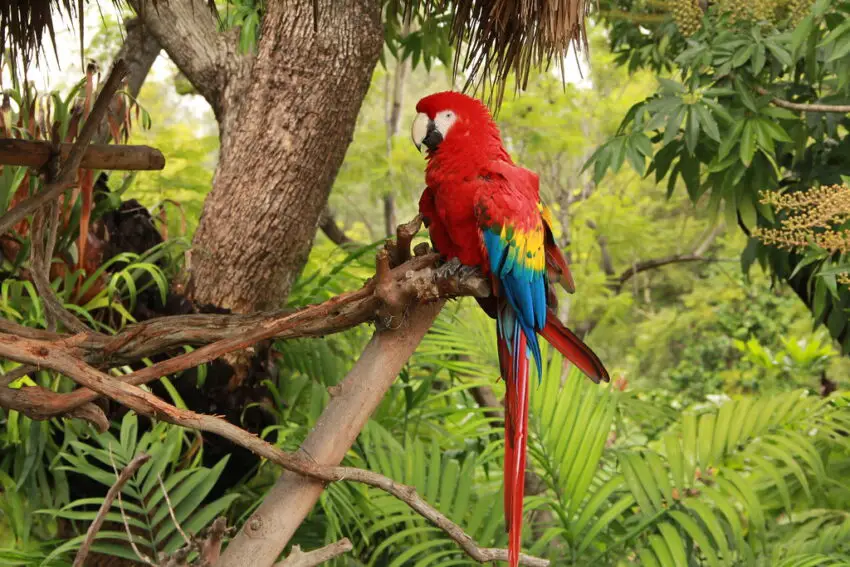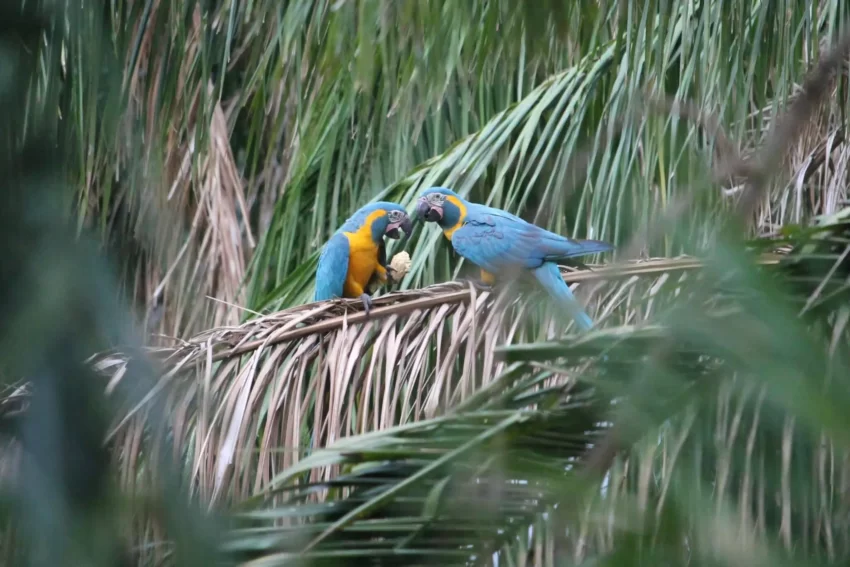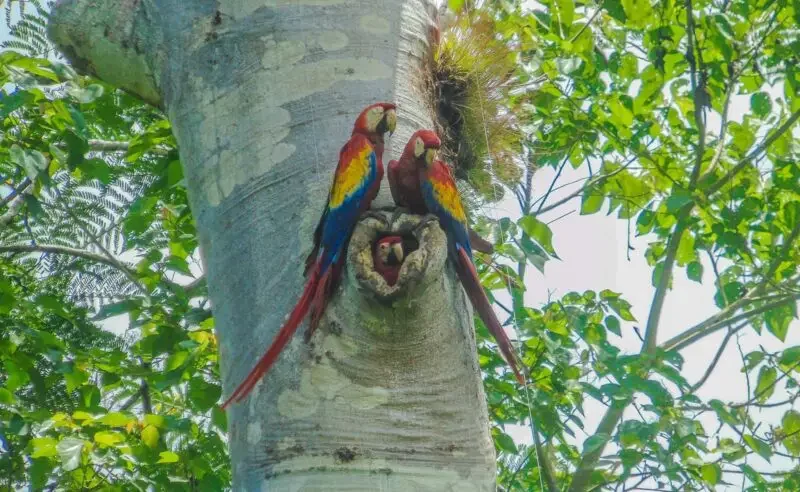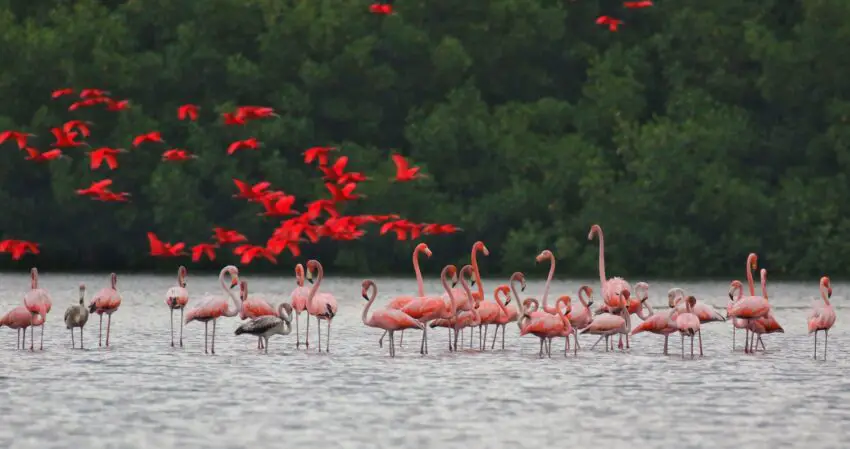Macaw Natural habitat is a provides us the information about the different habitat for macaw parrots all over the world. These enchanting parrots, renowned for their vibrant plumage and charismatic personalities, inhabit some of the world’s most biodiverse regions. If you want to know about the Macaw parrot price in India click here.
Discover the astounding diversity of macaw species that grace these tropical havens. From the resplendent Scarlet Macaw, draped in scarlet and cobalt, to the regal Hyacinth Macaw, with its deep blue feathers and piercing gaze, each species possesses its own unique charm and allure. Witness macaws soaring gracefully through the upper canopy, their powerful wings carrying them effortlessly amidst a tapestry of leaves and branches.
In this article, we invite you to embark on a captivating journey as we delve into the Macaw Natural Habitat, unraveling the secrets of their vibrant world. So, take a deep breath, let your imagination soar, and prepare to embark on an unforgettable adventure as we delve into the captivating and vibrant world of the macaw’s natural habitat.
Macaw Natural Habitat to Watch Out
Step into the vibrant world of macaws, where stunning colors blend with the sounds of the rainforest. These magnificent parrots, known for their vivid plumage and captivating personalities, inhabit some of the most biodiverse regions on Earth. In this article, we embark on a journey to explore the macaw natural habitat of macaws, unveiling the enchanting landscapes they call home.
Tropical Rainforests Macaw

The Rainforest Symphony: Step into the enchanting realm of tropical rainforests, where an orchestra of sights, sounds, and scents captivates the senses. These verdant landscapes, characterized by dense canopies, towering trees, and a rich tapestry of plant life, provide the perfect backdrop for macaws to thrive. Explore the vibrant layers of the rainforest, from the emergent giants that pierce the sky to the lush understory teeming with life.
Macaws’ Ecological Role: Within this ecological masterpiece, macaws play a vital role as seed dispersers. As they feast on a variety of fruits and nuts, they inadvertently transport seeds across vast distances, aiding in the forest’s regeneration and contributing to its remarkable diversity. Discover the intricate interdependence between macaws and the rainforest, where their foraging habits influence the composition and dynamics of plant communities.
Canopy Dwellers: Ascending to the upper realms of the rainforest, macaws find their preferred niche within the vibrant canopy. Equipped with strong beaks and agile flight, these majestic birds navigate the leafy expanse with grace and dexterity. Delve into the secrets of their canopy existence, where they find abundant food sources, nesting sites, and social interactions that shape their lives.
Floral Feast: Among the countless botanical treasures found in the rainforest, macaws have evolved to savor an assortment of fruits, nuts, seeds, and blossoms. Discover the delicacies that sustain macaws, from the succulent offerings of palm trees to the nectar-filled blooms that tempt their taste buds. Uncover the fascinating adaptations that enable macaws to extract nourishment from these bountiful sources.
A Biodiversity Hotspot: Tropical rainforests, renowned as biodiversity hotspots, provide a haven for countless species, including an array of Macaw Natural Habitat varieties. Explore the remarkable diversity of macaw species found within these ecosystems, each uniquely adapted to its specific Macaw Natural Habitat. From the brilliant Scarlet Macaw to the iridescent Blue-and-yellow Macaw, marvel at the kaleidoscope of colors that graces the rainforest skies.
Threats to Macaw Tropical Rainforests: Sadly, macaw tropical rainforests face severe threats due to human activities. Deforestation, driven by agricultural expansion, logging, and infrastructure development, poses a significant risk to these delicate ecosystems. Illegal wildlife trade and Macaw Natural Habitat fragmentation further exacerbate the challenges faced by macaws and their rainforest homes.
Conservation Efforts: Despite the challenges, dedicated individuals, organizations, and governments are actively engaged in safeguarding macaw tropical rainforests. Discover the inspiring initiatives aimed at preserving these invaluable Macaw Natural Habitat, including reforestation projects, protected areas, and sustainable practices. Learn how local communities are integral to the conservation efforts, ensuring a harmonious coexistence between humans and Macaw Natural Habitat.
Savannas and Grasslands Macaw

While macaw parrots are often associated with the lush rainforests of South America, they have also found a niche in the vast savannas and grasslands of certain regions. These unique ecosystems, characterized by grasses and scattered trees, are home to a diverse array of wildlife and play a crucial role in the planet’s ecology.
Abundance of Food Sources: Savannas and grasslands offer a wide array of food sources that cater to the dietary requirements of macaw parrots. These birds are primarily herbivorous, feeding on a variety of fruits, seeds, nuts, and vegetation. Grasslands provide an ample supply of grass seeds, which serve as a vital food source for macaws. Additionally, these Macaw Natural Habitat are home to various fruit-bearing trees and shrubs that produce fruits rich in essential nutrients, ensuring a balanced diet for the macaw parrots.
Nesting and Breeding Opportunities: Macaw parrots are highly social birds, and savannas and grasslands offer suitable nesting and breeding opportunities for them. The open and spacious landscape allows for the formation of large communal nests in tree cavities or on cliffs, which can accommodate several macaw pairs. The abundance of trees and suitable nesting sites enables macaws to establish and maintain their breeding colonies, contributing to the conservation of these magnificent birds.
Species Diversity and Interactions: Savannas and grasslands are known for their remarkable biodiversity, hosting a wide range of plant and animal species. This ecosystem complexity fosters a rich network of ecological interactions, including pollination, seed dispersal, and predator-prey relationships. Macaw parrots, with their vibrant colors and distinct calls, play a significant role in these interactions. They aid in seed dispersal by consuming fruits and later excreting the seeds, which contributes to the regeneration of vegetation across the savannas and grasslands.
Adaptation and Survival: Macaw parrots have adapted to the environmental conditions of savannas and grasslands over time. The open landscape allows them to take flight easily and travel long distances in search of food and water. Furthermore, macaws have developed powerful beaks that help them crack open hard nuts and seeds found in these Macaw Natural Habitat. Their strong beaks also aid in excavating tree cavities for nesting purposes.
Conservation Importance: The conservation of savannas and grasslands is crucial for the survival of macaw parrots and other species that rely on this ecosystem. Unfortunately, these Macaw Natural Habitat face various threats, such as habitat loss due to agriculture, unsustainable grazing practices, and climate change. Efforts must be made to protect and restore these ecosystems, ensuring the long-term survival of macaw parrots and preserving the biodiversity they support.
Subtropical and Temperate Forests Macaw

While most macaw species inhabit tropical regions, some can be found in subtropical and temperate forests. These Macaw Natural Habitat have a milder climate, characterized by distinct seasons. Macaws in these regions adapt to the changing environment, adjusting their diet and nesting behavior accordingly. They rely on a variety of tree species, including pines and oaks, which provide suitable nesting sites and food sources such as acorns, berries, and pine seeds.
Biodiversity and Food Sources: Subtropical forests are brimming with diverse plant species that provide nourishment for macaw parrots. Fruits, nuts, seeds, and flowers are essential components of their diet. The macaws play a vital role in seed dispersal, aiding in the regeneration and growth of the forest.
Nesting and Breeding: Macaw Natural Habitat seek out the secure and secluded areas within the subtropical forest to build their nests. These forests offer a plethora of suitable tree cavities and natural hollows, providing safe havens for breeding and raising their young.
Seasonal Adaptations: Macaw parrots dwelling in temperate forests adapt to the changing seasons. They exhibit remarkable resilience in surviving colder winters by seeking out sheltered areas and relying on the available food sources, such as seeds, nuts, and berries, which are abundant during the warmer months.
Protection: Within the dense foliage and old-growth trees, macaw parrots find ideal locations for nesting and shelter. The hollows and crevices in the trunks and branches offer protection from predators and adverse weather conditions, ensuring the safety of their young.
Reforestation and Habitat Restoration: Conservation organizations and governments play a crucial role in protecting and restoring these forests. Reforestation initiatives, including the planting of native tree species, help to reclaim lost habitats and create sustainable ecosystems for macaw parrots and other wildlife.
Community Engagement and Education: Raising awareness about the importance of subtropical and temperate forests is vital for their preservation. Educating local communities about the ecological significance of these habitats and promoting sustainable practices fosters a sense of responsibility and encourages active participation in conservation efforts.
Mangroves and Coastal Regions Macaw

Macaw parrots have long been admired for their brilliant colors and charismatic personalities, typically associated with lush rainforests. However, these remarkable birds have also found a niche in the coastal regions and mangrove forests of the world.
Coastal Mangroves: Coastal mangroves are specialized ecosystems characterized by a unique combination of saltwater and freshwater environments. These coastal wonders are found in regions such as Southeast Asia, Australia, and parts of Central and South America. Despite their inhospitable conditions, macaws have managed to carve out a place in these coastal habitats.
Macaw Species in Coastal Mangroves: Several macaw species have adapted to thrive in coastal mangroves, including the Red-fronted Macaw (Ara rubrogenys) and the Blue-winged Macaw (Primolius maracana). These macaws display distinct characteristics and adaptations that enable them to survive and thrive in these coastal environments.
Feeding and Foraging Strategies: Macaw Natural Habitat in coastal regions have unique foraging strategies to obtain their food. They rely on the abundance of mangrove fruits, nuts, and seeds, as well as specialized food sources found in the coastal ecosystem. They have adapted to extract these resources and have become an integral part of the coastal food web.
Nesting and Breeding Challenges: Nesting in coastal areas presents its own set of challenges for macaws. They often select tree hollows or cliff ledges within the mangrove forests as their nesting sites. Tides, saltwater exposure, and the ever-changing coastal environment pose hurdles that macaws must overcome during the nesting and breeding season.
Adaptations to Coastal Environments: Macaws in mangroves and coastal regions have developed unique adaptations to survive in this challenging environment. These include physiological adaptations like salt tolerance and waterproofing features, as well as behavioral adaptations in flight patterns and social dynamics within the coastal macaw populations.
Conservation and Threats: Macaws in coastal habitats face significant conservation challenges. Macaw Natural Habitat loss due to coastal development, pollution, and climate change poses a threat to their survival. Rising sea levels, altered salinity levels, and the degradation of mangrove forests further exacerbate the challenges faced by these magnificent birds.
Community Engagement and Conservation Initiatives: Conservation efforts aimed at protecting macaws in coastal areas involve active community engagement. Raising awareness about the importance of mangroves and their inhabitants, including macaws, is crucial. Community-led initiatives, scientific research, and government support play a vital role in the conservation and restoration of these coastal habitats.
Ecological Significance and Biodiversity Conservation: Macaws in coastal mangroves hold ecological significance by contributing to pollination, seed dispersal, and the overall health of the ecosystem. Protecting these birds and their habitats ensures the preservation of biodiversity and the delicate balance of the coastal ecosystem.
Conclusion
The exploration of the Macaw Natural Habitat parrots unveils a vibrant world full of awe-inspiring beauty, remarkable adaptations, and intricate ecological dynamics. From the lush rainforests of South America to unexpected Macaw Natural Habitat like savannas, grasslands, mangroves, and coastal regions, macaws have showcased their ability to adapt and thrive in diverse environments. Exploring the vibrant world of macaw natural habitat allows us to marvel at the wonders of nature and appreciate the delicate balance of ecosystems.
By recognizing the value of these Macaw Natural Habitat and actively working towards their preservation, we contribute to the ongoing conservation of these magnificent parrots and the ecosystems they call home. Ultimately, our collective efforts can ensure a brighter future for macaws, where their Macaw Natural Habitat remain a source of inspiration and wonder for the next generations to come.

